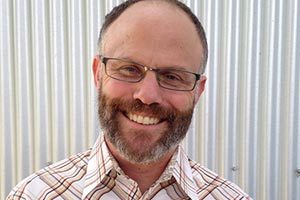Kif Scheuer
“By 2050, we could live in a much different, much safer, healthier and more vibrant California.”
Kif Scheuer
Climate Change Program Director, Local Government Commission
 Working on addressing climate change, I have to be optimistic about the future, but it’s also important to be pragmatic about how we get there.
Working on addressing climate change, I have to be optimistic about the future, but it’s also important to be pragmatic about how we get there.
Living in California that optimistic pragmatism is all around us and it’s showing results. We have set emissions goals for 2020, and are on track to meet them. Through AB32, subsequent legislation and local action, we have demonstrated the foundation of optimistic pragmatism that will be needed to carry us forward. We already engaging in statewide conversations about 2030 goals that will intensify this momentum. By 2050, we could live in a much different, much safer, healthier and more vibrant California.
However to get to that 2050 – to reach an 80% reduction in greenhouse gases while protecting our collective well-being – Our public sector will need to dramatically scale up adoption of the many practical solutions that have already gotten us this far.
At the individual level, our homes and cars need to become functional components of a more secure distributed energy grid. Our cities and towns need to engage in data driven dialogue with citizens to manage their investments based on forward looking risk analysis and a need to optimize resources for public goods. Regions need to coordinate as never before, as threats from boundaryless challenges such as sea-level rise force communities to engage in cooperative responses. The state too needs to adopt a robust risk management perspective, as it expands it’s analytic and funding resources to support smart local responses under highly uncertain conditions.
But there will be incredible challenges involved in changing the way we live and manage our communities.
As climate change unfolds around us, we will be challenged to adopt such forward-looking, networked government structures and policies. This will not be comfortable nor easy. Unaccustomed to planning for uncertainty and the tough calculus of risk management, local and state policy makers will be challenged to rethink the way they manage their resources and deploy their limited capacities. We will also be challenged to pay more than lip service to vulnerable populations, because tectonic shifts in the structure of communities are far more likely to leave behind those with less resources and political voice.
Fortunately, policymakers, entrepreneurs and visionaries are increasingly turning their talents to tackle this problem. The Local Government Commission is proud to share the thoughts of a few of our colleagues – leaders whose pragmatic approaches are helping make California communities stronger today and who give me the optimism that we will see a stronger future tomorrow.
Local Government Commission Newsletters
Livable Places Update
CURRENTS Newsletter
CivicSpark™ Newsletter
LGC Newsletters
Keep up to date with LGC’s newsletters!
Livable Places Update – April
April’s article: Microtransit: Right-Sizing Transportation to Improve Community Mobility
Currents: Spring 2019
Currents provides readers with current information on energy issues affecting local governments in California.
CivicSpark Newsletter – March
This monthly CivicSpark newsletter features updates on CivicSpark projects and highlights.



